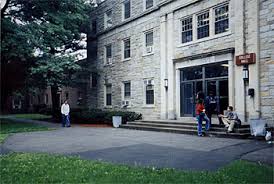
Like many other first years, I was very nervous about moving away from home for the first time. I didn’t know my roommate, I’d never been to New Paltz for more than a tour and I’d never stayed away from home for longer than a few weeks. It was all very scary.
Luckily, thanks to making some friends in my orientation group, (shout out to Dais of Our Fives, the best orientation group ever), I had a few friends in the hall I chose a room in.
I had chosen Shango Hall room 222.
It was an easy number to remember. I knew other people I knew would be there, and even my very own orientation leader, Dai, would be an RA there. It seemed perfect!
However, that’s when I began to hear some very disheartening things about Shango Hall, or as Shango and College Halls are colloquially referred to, Collango Hall. I heard that it was dirty and old. I heard that everything was broken. There were lots of complaints about lack of air conditioning, despite most residence halls not having it.
Even a google search for Shango Hall yields rough results. On OneClass.com, Melissa Paniagua reported a list of SUNY New Paltz Halls from worst to best. Shango/College Halls were ranked the worst on campus. Paniagua writes that “the dorm itself has mold in the showers, bumps on the ceilings and walls, and has a current ant infestation in the dorm kitchen…[and] the water turns brown at times and the bathrooms have no paper towels or hand dryers.”
Yet, there was no mention of the option to submit work orders, which staff told us frequently that we can use to inform them of things that were broken around the hall. There was also no mention that most residence halls don’t have paper towels or hand dryers, or quite frankly, that many places, not just residence halls, have an ant infestation once in a while.
I’m a fifth-year residential student, and Shango Hall is the hall I’ve lived in the longest. I stayed there for three semesters. It was one of the most fun living experiences I’ve had on campus.
Yes, sometimes the washing machines broke down, or the water turned brown, or something broke. But, honestly, I’ve experienced all of that in the other halls as well. I’ve even experienced all of it in my family’s apartment in Brooklyn, so maybe I’m just used to it. Yet, regardless, none of it took away from the fun. Everyone had their doors open in the late summer, early fall heat, making it super easy to make friends. There were multiple lounges in the basement which gave ample space to hang out with new found friends. And throughout both Shango and College Halls, there are murals decorating the walls.
They have a very important story behind them that not many people know about.
Tanique Williams wrote an article about the murals for The Little Rebellion and explained that the murals depict things like “images of prominent civil rights figures like Malcolm X, a depiction of the seven principles of Kwanzaa (upon which the hall was founded), various poems and a depiction of a lynching.”
The murals were painted by students who lived in Shango and College Halls. When I was a member of Hall Government in Shango Hall, we gave tours to returning alumni who came back to visit their old halls. I had the privilege of meeting people who remembered the murals.
The murals, and Shango Hall itself, are a very important part of campus history. From 1971 to 2001, the Black Studies Department was located in Shango Hall. Williams reported in the article that Shango was a place where “where students of color lived, took classes and participated in cultural events, according to an article titled “Chango: The Need To Exist” printed in a 1975 issue of Fahari.”
Even the name of “Shango” has a meaning that most students don’t know about. Amayah Spence in a previous Oracle article wrote “The name Shango is in honor of the Nigerian religion, Yoruba. Shango is a powerful Yorubian god of thunder who students selected to represent and be a protective presence over their dorms.” In addition Spence pointed out that many students also mispronounce the name “it’s pronounced shanGŌ, not SHANgo.
And I, as a white person, had the immense privilege to be able to live in Shango Hall with its extremely important history and to be able to walk among the murals and learn about them while I lived there.
Despite the rich history of Shango and College Halls being readily available online and via word of mouth, I still continue to hear people bash the halls today.
College and Shango Halls deserve so much more and they are truly an honor to live in. So to all the incoming students out there, please know that it is awesome to live in Shango and College Halls.
